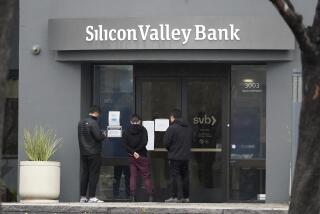Lincoln S&L;’s Quarterly Loss Is $109 Million
- Share via
Insolvent Lincoln Savings & Loan lost $109 million in the third quarter ended Sept. 30, sinking it further into a vast pool of red ink that will make it one of the costliest S&L; bailouts.
The Irvine-based thrift, under regulatory control since April, 1989, lost more than $400 million in the first nine months of 1990 and more than $1.4 billion since the beginning of 1989, according to the Office of Thrift Supervision.
At the end of September, the thrift had $2.6 billion in assets and a negative net worth--a measure of how much its debts exceeded assets--of more than $1.9 billion. Negative net worth provides the most current indication of what Lincoln’s bailout will cost taxpayers.
Regulators have estimated that the ultimate cost will be more than $2 billion. Lincoln’s negative net worth had likely plunged beyond that figure in last year’s fourth quarter. The final quarter’s results won’t be released for about three months.
The cost to taxpayers will depend, in part, on how successful regulators are at selling Lincoln’s assets and recovering awards in court judgments from Lincoln’s former operators, including Phoenix businessman Charles H. Keating Jr. Keating is facing several major civil suits and has been indicted on state securities fraud charges.
The Resolution Trust Corp., which manages Lincoln, has filed a $1.1 billion racketeering suit against Keating and his former aides.
Regulators seized the high-flying thrift in 1989, a day after its parent, American Continental Corp., filed for bankruptcy protection. The company is being liquidated. Regulators are selling the S&L;’s assets as they look for a buyer for its 29 branches in Southern California.
Just how far the S&L; strayed from traditional investments can be seen in two third-quarter statistics. First, its residential loans amounted to just $57.1 million in a $1.65-billion loan portfolio. Secondly, the amount it paid to depositors and others in interest was $73.3 million more than than the amount it earned in interest from loans and investments it had made under Keating. The thrift is not making any new loans.
Lincoln invested heavily in risky real estate and junk bond investments. Regulators are continuing to write down the value of those holdings.
The thrift at one time held more than $600 million in junk bonds. Some of those securities have been sold and others revalued. At the end of the third quarter, the junk bond portfolio was valued at $381 million.
The S&L;’s real estate portfolio includes $1.5 billion in raw-land loans, much of it to builders who bought Lincoln’s desert holdings. Those loans have been written down to $281.2 million, the quarterly results show.
“With securities, regulators have a good gauge on what they can be sold on the market for, so you can understand the writedowns,” said Gerry Findley, a financial institutions consultant in Brea.
“But writing down mortgage loans is simply judgment,” he said.
More to Read
Inside the business of entertainment
The Wide Shot brings you news, analysis and insights on everything from streaming wars to production — and what it all means for the future.
You may occasionally receive promotional content from the Los Angeles Times.










